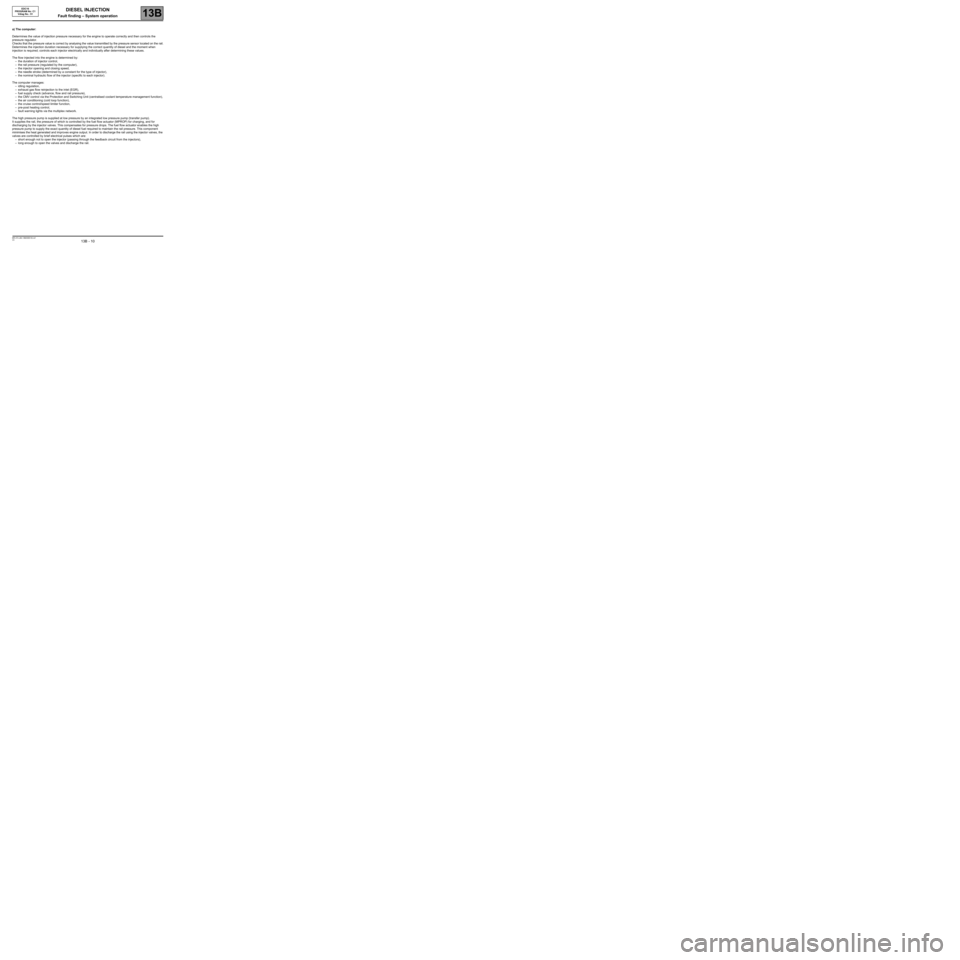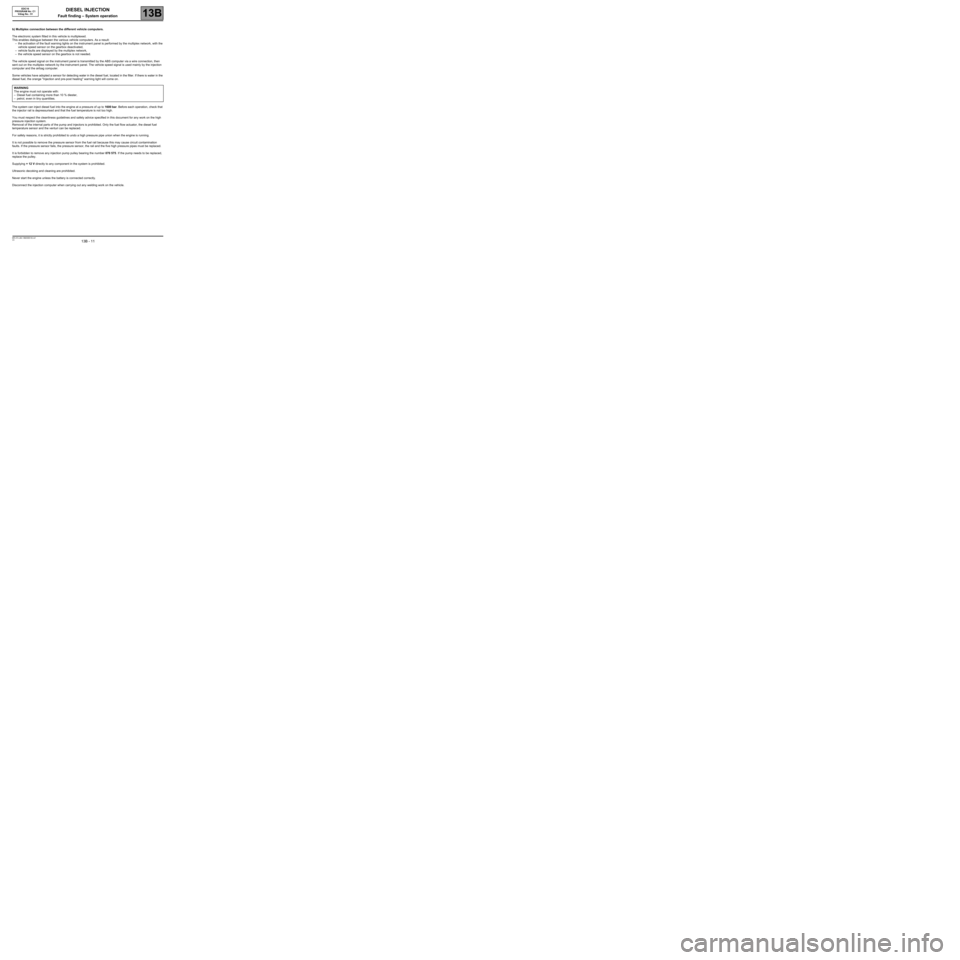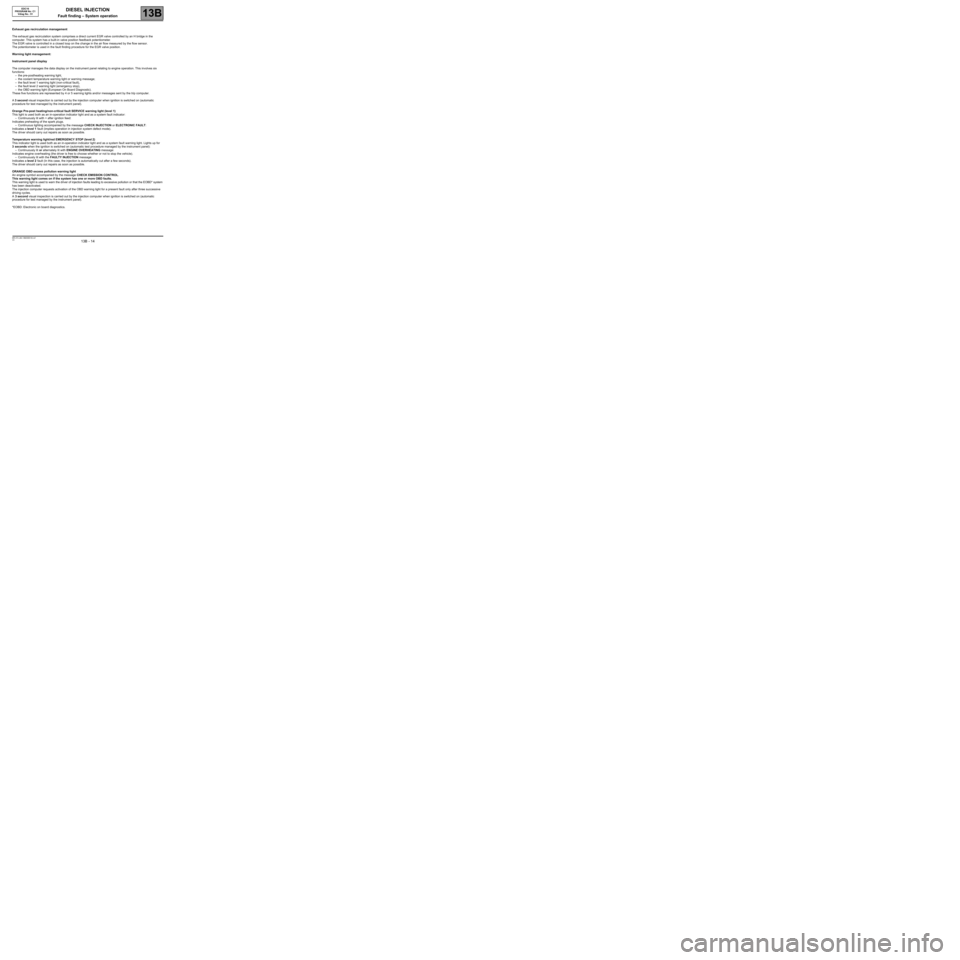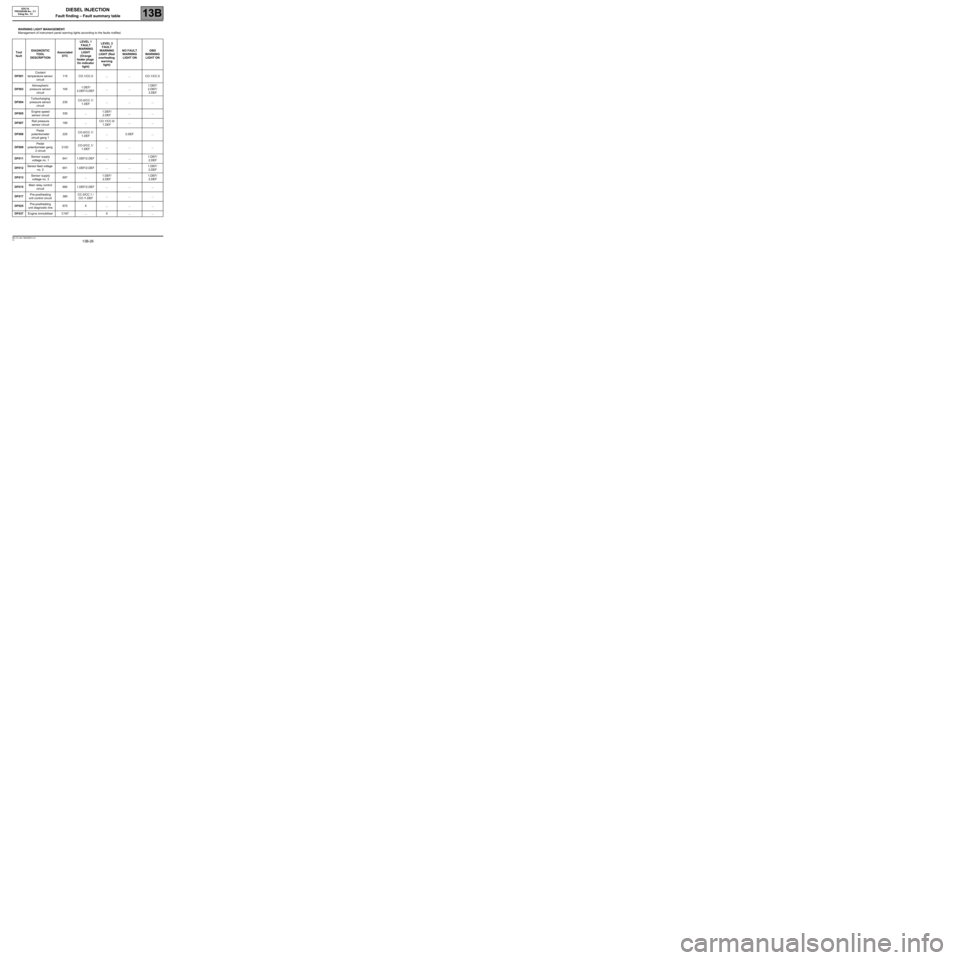warning lights RENAULT SCENIC 2009 J84 / 2.G Engine And Peripherals EDC16 Workshop Manual
[x] Cancel search | Manufacturer: RENAULT, Model Year: 2009, Model line: SCENIC, Model: RENAULT SCENIC 2009 J84 / 2.GPages: 273
Page 10 of 273

DIESEL INJECTION
Fault finding – System operation13B
13B - 10V3 MR-372-J84-13B250$135.mif
EDC16
PROGRAM No: C1
Vdiag No.: 51
a) The computer:
Determines the value of injection pressure necessary for the engine to operate correctly and then controls the
pressure regulator.
Checks that the pressure value is correct by analysing the value transmitted by the pressure sensor located on the rail.
Determines the injection duration necessary for supplying the correct quantity of diesel and the moment when
injection is required; controls each injector electrically and individually after determining these values.
The flow injected into the engine is determined by:
–the duration of injector control,
–the rail pressure (regulated by the computer),
–the injector opening and closing speed,
–the needle stroke (determined by a constant for the type of injector),
–the nominal hydraulic flow of the injector (specific to each injector).
The computer manages:
–idling regulation,
–exhaust gas flow reinjection to the inlet (EGR),
–fuel supply check (advance, flow and rail pressure),
–the CMV control via the Protection and Switching Unit (centralised coolant temperature management function),
–the air conditioning (cold loop function),
–the cruise control/speed limiter function,
–pre-post heating control,
–fault warning lights via the multiplex network.
The high pressure pump is supplied at low pressure by an integrated low pressure pump (transfer pump).
It supplies the rail, the pressure of which is controlled by the fuel flow actuator (MPROP) for charging, and for
discharging by the injector valves. This compensates for pressure drops. The fuel flow actuator enables the high
pressure pump to supply the exact quantity of diesel fuel required to maintain the rail pressure. This component
minimises the heat generated and improves engine output. In order to discharge the rail using the injector valves, the
valves are controlled by brief electrical pulses which are:
–short enough not to open the injector (passing through the feedback circuit from the injectors),
–long enough to open the valves and discharge the rail.
Page 11 of 273

DIESEL INJECTION
Fault finding – System operation13B
13B - 11V3 MR-372-J84-13B250$135.mif
EDC16
PROGRAM No: C1
Vdiag No.: 51
b) Multiplex connection between the different vehicle computers.
The electronic system fitted in this vehicle is multiplexed.
This enables dialogue between the various vehicle computers. As a result:
–the activation of the fault warning lights on the instrument panel is performed by the multiplex network, with the
vehicle speed sensor on the gearbox deactivated,
–vehicle faults are displayed by the multiplex network,
–the vehicle speed sensor on the gearbox is not needed.
The vehicle speed signal on the instrument panel is transmitted by the ABS computer via a wire connection, then
sent out on the multiplex network by the instrument panel. The vehicle speed signal is used mainly by the injection
computer and the airbag computer.
Some vehicles have adopted a sensor for detecting water in the diesel fuel, located in the filter. If there is water in the
diesel fuel, the orange "Injection and pre-post heating" warning light will come on.
The system can inject diesel fuel into the engine at a pressure of up to 1600 bar. Before each operation, check that
the injector rail is depressurised and that the fuel temperature is not too high.
You must respect the cleanliness guidelines and safety advice specified in this document for any work on the high
pressure injection system.
Removal of the internal parts of the pump and injectors is prohibited. Only the fuel flow actuator, the diesel fuel
temperature sensor and the venturi can be replaced.
For safety reasons, it is strictly prohibited to undo a high pressure pipe union when the engine is running.
It is not possible to remove the pressure sensor from the fuel rail because this may cause circuit contamination
faults. If the pressure sensor fails, the pressure sensor, the rail and the five high pressure pipes must be replaced.
It is forbidden to remove any injection pump pulley bearing the number 070 575. If the pump needs to be replaced,
replace the pulley.
Supplying + 12 V directly to any component in the system is prohibited.
Ultrasonic decoking and cleaning are prohibited.
Never start the engine unless the battery is connected correctly.
Disconnect the injection computer when carrying out any welding work on the vehicle.WARNING
The engine must not operate with:
–Diesel fuel containing more than 10 % diester,
–petrol, even in tiny quantities.
Page 14 of 273

DIESEL INJECTION
Fault finding – System operation13B
13B - 14V3 MR-372-J84-13B250$135.mif
EDC16
PROGRAM No: C1
Vdiag No.: 51
Exhaust gas recirculation management
The exhaust gas recirculation system comprises a direct current EGR valve controlled by an H bridge in the
computer. This system has a built-in valve position feedback potentiometer.
The EGR valve is controlled in a closed loop on the change in the air flow measured by the flow sensor.
The potentiometer is used in the fault finding procedure for the EGR valve position.
Warning light management:
Instrument panel display
The computer manages the data display on the instrument panel relating to engine operation. This involves six
functions:
–the pre-postheating warning light,
–the coolant temperature warning light or warning message;
–the fault level 1 warning light (non-critical fault),
–the fault level 2 warning light (emergency stop),
–the OBD warning light (European On Board Diagnostic).
These five functions are represented by 4 or 5 warning lights and/or messages sent by the trip computer.
A 3 second visual inspection is carried out by the injection computer when ignition is switched on (automatic
procedure for test managed by the instrument panel).
Orange Pre-post heating/non-critical fault SERVICE warning light (level 1)
This light is used both as an in-operation indicator light and as a system fault indicator:
–Continuously lit with + after ignition feed:
Indicates preheating of the spark plugs.
–Continuous lighting accompanied by the message CHECK INJECTION or ELECTRONIC FAULT:
Indicates a level 1 fault (implies operation in injection system defect mode).
The driver should carry out repairs as soon as possible.
Temperature warning light/red EMERGENCY STOP (level 2)
This indicator light is used both as an in-operation indicator light and as a system fault warning light. Lights up for
3 seconds when the ignition is switched on (automatic test procedure managed by the instrument panel):
–Continuously lit or alternately lit with ENGINE OVERHEATING message:
Indicates engine overheating (the driver is free to choose whether or not to stop the vehicle).
–Continuously lit with the FAULTY INJECTION message:
Indicates a level 2 fault (In this case, the injection is automatically cut after a few seconds).
The driver should carry out repairs as soon as possible.
ORANGE OBD excess pollution warning light
An engine symbol accompanied by the message CHECK EMISSION CONTROL.
This warning light comes on if the system has one or more OBD faults.
This warning light is used to warn the driver of injection faults leading to excessive pollution or that the EOBD* system
has been deactivated.
The injection computer requests activation of the OBD warning light for a present fault only after three successive
driving cycles.
A 3 second visual inspection is carried out by the injection computer when ignition is switched on (automatic
procedure for test managed by the instrument panel).
*EOBD: Electronic on board diagnostics.
Page 26 of 273

DIESEL INJECTION
Fault finding – Fault summary table13B
13B-26V3 MR-372-J84-13B250$270.mif
EDC16
PROGRAM No.: C1
Vdiag No.: 51DIESEL INJECTION
Fault finding – Fault summary table
WARNING LIGHT MANAGEMENT:
Management of instrument panel warning lights according to the faults notified.
Tool
faultDIAGNOSTIC
TOOL
DESCRIPTIONAssociated
DTCLEVEL 1
FAULT
WARNING
LIGHT
(Orange
heater plugs
On indicator
light)LEVEL 2
FAULT
WARNING
LIGHT (Red
overheating
warning
light)NO FAULT
WARNING
LIGHT ONOBD
WARNING
LIGHT ON
DF001Coolant
temperature sensor
circuit115 CO.1/CC.0 ... ... CO.1/CC.0
DF003Atmospheric
pressure sensor
circuit1051.DEF/
2.DEF/3.DEF... ...1.DEF/
2.DEF/
3.DEF
DF004Turbocharging
pressure sensor
circuit235CO.0/CC.1/
1.DEF... ... ...
DF005Engine speed
sensor circuit335 ...1.DEF/
2.DEF... ...
DF007Rail pressure
sensor circuit190 ...CO.1/CC.0/
1.DEF... ...
DF008Pedal
potentiometer
circuit gang 1225CO.0/CC.1/
1.DEF... 2.DEF ...
DF009Pedal
potentiometer gang
2 circuit2120CO.0/CC.1/
1.DEF... ... ...
DF011Sensor supply
voltage no. 1641 1.DEF/2.DEF ... ...1.DEF/
2.DEF
DF012Sensor feed voltage
no. 2651 1.DEF/2.DEF ... ...1.DEF/
2.DEF
DF013Sensor supply
voltage no. 3697 ...1.DEF/
2.DEF...1.DEF/
2.DEF
DF015Main relay control
circuit685 1.DEF/2.DEF ... ... ...
DF017Pre-postheating
unit control circuit380CC.0/CC.1 /
CO /1.DEF... ... ...
DF025Pre-postheating
unit diagnostic line670 X ... ... ...
DF037Engine immobiliser C167 ... X ... ...